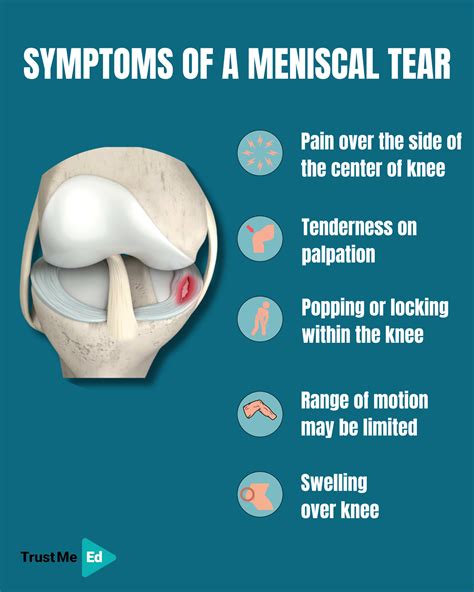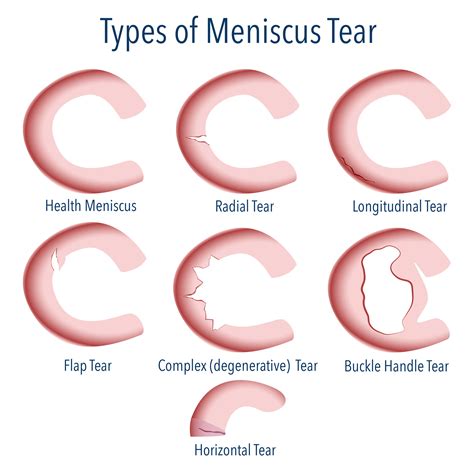Intro
Discover 5 ways meniscus tear surgery can alleviate knee pain, featuring arthroscopic procedures, meniscectomy, and repair techniques, improving joint stability and reducing osteoarthritis risks, for optimal orthopedic recovery and rehabilitation.
The meniscus is a crucial component of the knee joint, providing cushioning and support to the bones. However, it can be prone to injuries, particularly tears, which can be painful and debilitating. Meniscus tear surgery is often necessary to repair or remove the damaged tissue, allowing patients to regain mobility and alleviate discomfort. In this article, we will delve into the world of meniscus tear surgery, exploring the different approaches, benefits, and what patients can expect from the procedure.
Meniscus tears can occur due to various reasons, including sports injuries, aging, or sudden twists and turns. The symptoms of a meniscus tear can vary, but common complaints include pain, swelling, and stiffness in the knee. In some cases, patients may experience locking or catching sensations, making it difficult to move the knee. If left untreated, meniscus tears can lead to further complications, such as osteoarthritis or chronic pain. Therefore, seeking medical attention is essential to prevent long-term damage.
The diagnosis of a meniscus tear typically involves a combination of physical examinations, imaging tests, and medical history. Doctors may use X-rays, MRIs, or CT scans to confirm the presence of a tear and assess its severity. Once the diagnosis is confirmed, the next step is to discuss treatment options with an orthopedic surgeon. Meniscus tear surgery is often recommended for patients who have not responded to conservative treatments, such as physical therapy or pain management. The goal of surgery is to repair or remove the damaged meniscus, allowing patients to regain knee function and alleviate pain.
Understanding Meniscus Tear Surgery

Benefits of Meniscus Tear Surgery
The benefits of meniscus tear surgery are numerous, and patients can expect significant improvements in their quality of life. Some of the advantages of meniscus tear surgery include: * Reduced pain and discomfort * Improved knee function and mobility * Decreased risk of further complications, such as osteoarthritis * Faster recovery times compared to conservative treatments * Minimally invasive procedures, reducing scarring and trauma to the surrounding tissueTypes of Meniscus Tear Surgery

What to Expect from Meniscus Tear Surgery
Meniscus tear surgery is typically performed on an outpatient basis, and patients can expect to return home the same day. The procedure is usually done under general anesthesia, and the surgeon will use a combination of arthroscopic and open techniques to access the damaged meniscus. After the procedure, patients can expect to experience some pain, swelling, and stiffness, which can be managed with pain medication and physical therapy. The recovery time varies depending on the type of surgery and the individual patient, but most people can expect to return to normal activities within 6-12 weeks.Recovery and Rehabilitation

Common Complications and Risks
As with any surgical procedure, meniscus tear surgery carries some risks and complications. Common issues include: * **Infection**: Patients may be at risk of developing an infection, which can be treated with antibiotics. * **Bleeding or hematoma**: Patients may experience bleeding or hematoma, which can be managed with medication or drainage. * **Nerve damage**: Patients may experience numbness or tingling sensations due to nerve damage, which can be temporary or permanent. * **Knee stiffness**: Patients may experience stiffness or limited mobility in the knee, which can be addressed with physical therapy.Conclusion and Next Steps

We invite you to share your thoughts and experiences with meniscus tear surgery in the comments below. If you have any questions or concerns, please do not hesitate to reach out to us. We are committed to providing you with the most up-to-date and accurate information on meniscus tear surgery and other orthopedic topics.
What are the symptoms of a meniscus tear?
+The symptoms of a meniscus tear can include pain, swelling, and stiffness in the knee, as well as locking or catching sensations.
How long does meniscus tear surgery take to recover from?
+The recovery time for meniscus tear surgery varies depending on the type of surgery and the individual patient, but most people can expect to return to normal activities within 6-12 weeks.
What are the risks and complications of meniscus tear surgery?
+Common complications and risks of meniscus tear surgery include infection, bleeding or hematoma, nerve damage, and knee stiffness.
